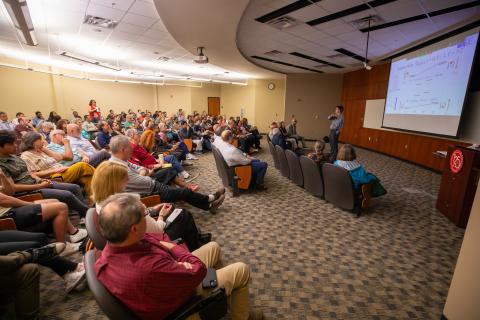On August 8th, two of our Geosciences graduate students, Ujjwal Kharel and Hamza Rehman, had an amazing opportunity
An Engaging Lecture by Nobel Laureate Eric Cornell
Fri, 11/24/2023 - 11:50amNobel laureate Dr. Eric Cornell from the University of Colorado and the National Institute of Standards and Technology (NIST) delivered the College of Sciences' 125th Anniversary Series Lecture on 24 October 2023. His talk, which was co-sponsored by the Herman D. Hughes Distinguished Lecture Series, was titled "Looking for Fossils of the Big Bang in Lab." The lecture was well-attended and there was a great deal of interaction with the audience.


Cornell explained how he, his research associate Jun Ye, and the researchers in the Cornell Group at JILA address fundamental questions such as why people like us exist at all. He noted that if there had been the same amount of matter and antimatter created in the Big Bang, the future of stars, galaxies, our solar system, and life would have disappeared in a flash of light as matter and antimatter recombined. But we know that’s not what happened. After matter-antimatter recombination, sufficient matter remained to form galaxies, stars, planets, and physicists who wonder why on Earth things turned out the way they did.
He proceeded to expand on how precision measurement of the shape of the electron may help them figure out the answer. Cornell and the JILA team think that in the beginning of the Universe, there must have been a slight excess of matter versus antimatter caused by tiny asymmetries in fundamental particles such as the electron. If, for example, the electron is ever so slightly egg-shaped (rather than round), then it may help explain why the scientists doing the experiment and the rest of the material universe exist.

The challenge faced by physicists investigating this conjecture is that an asymmetry in the electron’s shape––called an electron electric dipole moment, or eEDM––would be vanishingly small. If an atomic nucleus were the size of our solar system, then the eEDM (if there were one) would measure only a few millimeters. The actual eEDM (if there is one) might end up being measured in nonillionths or even decillionths of a centimeter (10-30–10-33 cm). These are breathtakingly short distances that require sophisticated physics experiments to precisely measure.
Determining the length of something this tiny not only requires creative experimental design, but also a profound understanding and application of precision measurement techniques. Fortunately, precision measurement of ultrasmall things is a specialty of the Cornell and his coworkers. The team recently used its sophisticated trapped-ion, rotating electric-field apparatus in its latest series of precision eEDM measurements.

The Cornell-Ye collaboration determined an upper limit for the eEDM of 1.3 x 10-28 e·cm, which is consistent with the upper limit of 9.3 x 10-29 e·cm found in a different experiment by the ACME collaboration between Harvard and Yale in 2014. In other words, even at such tiny distances as 10-28–10-29 cm, the electron is still round.
One very cool thing about this experiment is that the JILA team is positive its measurements were free of any bias on the part of the experimenters. The researchers did a year’s worth of experiments in different experimental configurations, all the while measuring the eEDM blind. Instead of having their computer tell them the results of individual measurements, they programmed the computer to add a random number to the results, so what the researchers saw after each measurement was a meaningless number. They did their experiments like this to keep their personal expectations, or bias, out of the results.
Then, after a year, they asked the computer for the answer. The answer was consistent with zero, meaning that at the level they could resolve, the electron was still round. However, they aren’t about to give up. They’re building a new experiment expected to resolve length measurements of 10-30 cm, tantilizingly close to where the researchers expect to see evidence of an eEDM, if it exists. The researchers responsible for this multiyear project to seek out and measure the eEDM include graduate students Will Cairncross, Dan Gresh, and Tanya Roussy, research associate Yan Zhou, former research associate Matt Grau, JILA Ph.D. and former research associate Kevin Cossel as well as Fellows Jun Ye and Eric Cornell.
(This description of the research discussed by Eric Cornell is a slightly edited version of a description posted by Julie Phillips on the JILA web site.)

